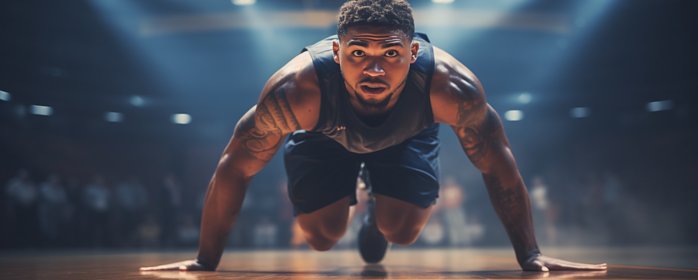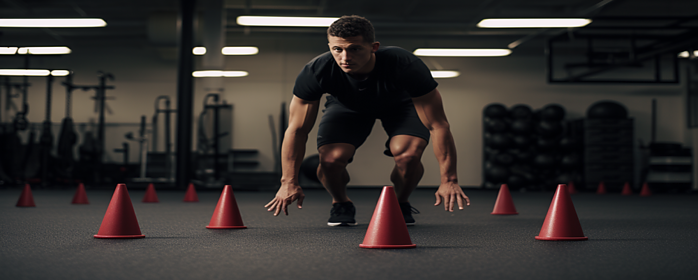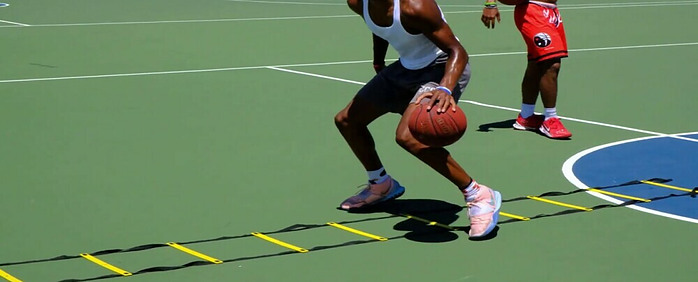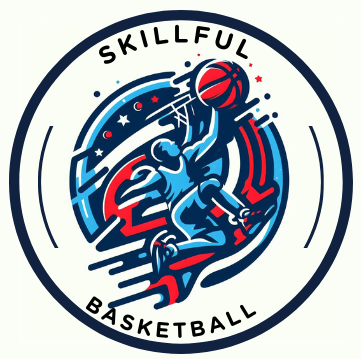
Think about the last time you watched an elite defender in action. I’m going to bet they didn’t just stand there; they were probably a blur, darting from one spot to another. That’s because speed and agility are non-negotiable traits for defensive roles in all sports, in particular basketball..
But it’s not just about outrunning the person with the ball…
Defensive speed means reacting quickly to plays as they develop, being able to accelerate, decelerate, and shift direction almost at the blink of an eye. Agility complements this by letting you move efficiently and with purpose, make sure your are always in position to make a play, whether that is directly on your check…or on help-side defense.
Being great at defense in basketball isn’t just about having the physical capability either; it’s also about the speed in which you “make decisios”. Your brain needs to be in sync with your body, and with the game. Quick judgment calls followed by rapid execution can mean the difference between a game-saving block and a narrow miss…or seeing a telegraphed pass before it is about to happen and reacting to it.
Guess what? Good drills can improve both your mind and body reflexes, and that is what we are going to be helping you with in this article. We’re going to jump into the mechanics of proper defensive footwork and how it serves as the bedrock for all your speed and agility work on the court.
The Foundations of Defensive Footwork
I’m going to break down why mastering your footwork is a game-changer, especially if you’re the defensive end of the court. The secret to being an effective defender isn’t just about YOUR speed; it’s about repetition of the precise steps that make you an effective defender. Every movement should be intentional and controlled, allowing you to react to any situation on the field swiftly.
Think of it. When you are defending in basketball, what are your most common moves on the court. You are running backwards lots, you are moving side to side in defensive stance, you are off-balance, and you are often times chasing your check through screens.
Emulating these movements will amplify your skills as a defender. Practice what you are doing, if you want to become better at it.
Now what does it take to improve balance and stability for those crucial moments during the game?
Drills. Lots of them.
Cone Drills are My Personal Favorite. Cone drills that mimic game-like scenarios, box drills that challenge your ability to shift direction while maintaining balance, even balance exercises that seem simple but pack a punch for your stability.

And it’s not just about moving forward or backward. Being unpredictable is key. Quick pivots, lateral shuffles, and reverse moves. Use the cones to your advantage, and side to side runs, S runs, as well as full sprints through the cones.
When you enhance your footwork, you don’t just improve your game; you also reduce the risk of injury. Better foot placement means less chance of a misstep leading to an ankle sprain or worse. It’s like giving your joints a suit of armor for the game.
You’ll be surprised how much faster you’ll feel on the court or field simply by being more efficient with your movements. Choose drills and exercises that resonate with you and that you feel are “game time” movements. Then watch as you become the player others have a tough time getting past and you are able to single handedly shut down the top offensive players on the opposing team.
Once you’ve laid the groundwork with defensive footwork, you’re ready to take things up a notch. That’s going to include short burst speed drills designed for explosive power, which is exactly what I’m going to be getting into next.
Speed Training: Boosting Quickness on the Court
The faster you are, the better you can close down space, keep up with fast attacking offensive players, and provide cover and help-side defense for your team. The skills required to improve speed are going to include a mix of short and long distances during your training.
First up, we have short burst speed drills. These are designed to enhance your explosive power, so you can hit top speed quickly. Think of them as your secret weapon when you need to suddenly chase down a ball or sprint to a strategic spot.
Some drills I recommend include:
- Sprints from a dead stop
- Shuttle runs
- And the classic ‘suicides’ that really push your acceleration. (you can hate me now for this one)
And here’s a pro tip: focus on your form. Proper running mechanics can shave precious microseconds off your sprint times. Perfect practice makes perfect, remember.
Interval training isn’t just about building endurance; it’s about maintaining your speed over the course of a game. You’re going to find out how to alternate between high-intensity sprints and recovery periods, which will help train your body to recover faster and sprint again without losing pace.
Lastly, resistance work can be a game-changer. Using tools like parachutes or sleds can increase your strength and power. This isn’t just about building muscle; it’s about teaching your muscles to perform under stress, which translates directly to better performance during matchplay.
Mastering Agility with Ladder Drills.
Now that you’ve got a taste of speed training, mastering agility is your next step. Agility ladder drills are an essential tool in your defensive training arsenal. These drills are specifically designed to improve your footwork, which is critical for changing directions quickly and efficiently on the field.

To start, design a routine that incorporates a variety of ladder drills. I’m going to walk you through a sequence that targets key components of agility: balance, speed, coordination, and reaction time. Choose something that fits into your overall training plan.
The benefits of this approach are twofold; you’re not only becoming faster but also much better at controlling your movements. This dual focus on speed and precision is what separates good defenders from great ones.
Here’s what a typical ladder drill session might include:
- The single-foot hop
- The lateral shuffle
- And the in-and-out drill.
Don’t worry too much about how fast you go when you’re just starting out. It’s more important to get the technique right. Once you nail the mechanics, the speed will come. You can always adjust your approach down the road, challenging yourself with new patterns and faster paces.
In conclusion, whether you’re a seasoned pro or just starting out, agility ladder drills are a game-changer for defensive players looking to step up their game.
So, put these practices into play and watch how quickly you can maneuver the field with newfound speed and grace. And remember, your first attempt doesn’t need to be your last—keep practicing, stay agile, and your defensive capabilities will follow.
Drop any feedback you have about any of the drills or strategies outline, and if you have a favorite defensive drill I would love to hear about it in the comments below.


Hey ! Your article brilliantly emphasizes the importance of intentional footwork, providing valuable insights into how drills, particularly cone drills and ladder drills, can elevate both physical and mental aspects of a player’s defensive game. The emphasis on form in speed training and the incorporation of interval training and resistance work add depth to the training regimen. A comprehensive guide for players looking to enhance their defensive prowess, with practical tips that resonate across skill levels, Well done and thank you for sharing your knowledge with us.
Perfect practice, leads to perfection (or closer to anyways). If you are practice poor form when it comes to defense or a shooting drill, that will lead to natural skill improvement and sustainable habits. People tend to think about form much more often in shooting than defense, but it plays a critical role in both!
Evening Kyle,
Just wanted to drop a quick note to say how much I loved your defensive drills guide! The bit about balance hit home – it’s something we all take for granted sometimes. Your reminder to work on it is spot-on.
Quick question, though: What’s the deal with “suicides”? Sounds intense, but I guess that’s why it works so well, right? Would love to get the lowdown on that. Thanks for the awesome tips and insights!
Cheers,
Dean
Suicides are a drill to reach maximum fatigue. When you get into the final minutes of a game, this can truly make a difference between the teams that are prepared properly from a cardio standpoint, and those that are not as conditioned.
Oftentimes the game comes down not to skills like shooting, but rather endurance and being able to out wit the competition and the Suicides are an excellent drill to do this (and one my coach always made us do).